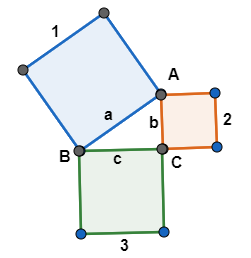
Answer
478.8k+ views
Hint: This theorem is generally used with triangles possessing an ${{90}^{\circ }}$ angle at one of its vertices, and the side present opposite to that angle is called Hypotenuse while remaining are either base or height.
“Complete step-by-step answer:”
Here, we have a theorem which is a fundamental relation in Euclidean geometry among the three sides of a right triangle called Pythagoras’ theorem stated as,
It states that, “The area of the square whose side is the hypotenuse is equal to the sum of the areas of the squares on the other two sides”.
This theorem can be written as an equation taking lengths of the sides of those squares as $a$ ,$b$ and $c$ respectively i.e.

Here, as per the theorem,
Square 1 has side length = $a$; while square 2 has side length = $b$; and square 3 has side length = $c$, thus, the area of the square whose side is the hypotenuse ($a$) is equal to the sum of the areas of the squares on the other two sides ($b$) and ($c$), i.e.,
\[\Rightarrow {{a}^{2}}={{b}^{2}}+{{c}^{2}}...\text{ }\left( 1 \right)\],
Where,
$a$ = side $AB$= Hypotenuse;
$b$= side $AC$= Perpendicular;
$c$= side $BC$= Base;
and $\angle ACB={{90}^{\circ }}$.
Hence, as per the Pythagoras’ theorem for a triangle consisting of a right angle from equation (1) is
${{a}^{2}}={{b}^{2}}+{{c}^{2}}$
Note: Important point to keep in mind here is the proper selection of hypotenuse. As we know that Pythagoras’ theorem is not generally applied in any triangle but with a triangle consisting of ${{90}^{\circ }}$ angle. And hypotenuse is always a side opposite to that right-angled vertex of a triangle.
“Complete step-by-step answer:”
Here, we have a theorem which is a fundamental relation in Euclidean geometry among the three sides of a right triangle called Pythagoras’ theorem stated as,
It states that, “The area of the square whose side is the hypotenuse is equal to the sum of the areas of the squares on the other two sides”.
This theorem can be written as an equation taking lengths of the sides of those squares as $a$ ,$b$ and $c$ respectively i.e.

Here, as per the theorem,
Square 1 has side length = $a$; while square 2 has side length = $b$; and square 3 has side length = $c$, thus, the area of the square whose side is the hypotenuse ($a$) is equal to the sum of the areas of the squares on the other two sides ($b$) and ($c$), i.e.,
\[\Rightarrow {{a}^{2}}={{b}^{2}}+{{c}^{2}}...\text{ }\left( 1 \right)\],
Where,
$a$ = side $AB$= Hypotenuse;
$b$= side $AC$= Perpendicular;
$c$= side $BC$= Base;
and $\angle ACB={{90}^{\circ }}$.
Hence, as per the Pythagoras’ theorem for a triangle consisting of a right angle from equation (1) is
${{a}^{2}}={{b}^{2}}+{{c}^{2}}$
Note: Important point to keep in mind here is the proper selection of hypotenuse. As we know that Pythagoras’ theorem is not generally applied in any triangle but with a triangle consisting of ${{90}^{\circ }}$ angle. And hypotenuse is always a side opposite to that right-angled vertex of a triangle.
Recently Updated Pages
How many sigma and pi bonds are present in HCequiv class 11 chemistry CBSE

Mark and label the given geoinformation on the outline class 11 social science CBSE

When people say No pun intended what does that mea class 8 english CBSE

Name the states which share their boundary with Indias class 9 social science CBSE

Give an account of the Northern Plains of India class 9 social science CBSE

Change the following sentences into negative and interrogative class 10 english CBSE

Trending doubts
Fill the blanks with the suitable prepositions 1 The class 9 english CBSE

Give 10 examples for herbs , shrubs , climbers , creepers

Change the following sentences into negative and interrogative class 10 english CBSE

Difference between Prokaryotic cell and Eukaryotic class 11 biology CBSE

The Equation xxx + 2 is Satisfied when x is Equal to Class 10 Maths

How do you graph the function fx 4x class 9 maths CBSE

Differentiate between homogeneous and heterogeneous class 12 chemistry CBSE

Application to your principal for the character ce class 8 english CBSE

Write a letter to the principal requesting him to grant class 10 english CBSE



